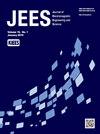The Design of a Sliding Rectangular Waveguide Array Antenna for Beam Steering
IF 1.7
3区 工程技术
Q3 ENGINEERING, ELECTRICAL & ELECTRONIC
Journal of electromagnetic engineering and science
Pub Date : 2023-05-31
DOI:10.26866/jees.2023.3.r.166
引用次数: 0
Abstract
In this paper, we designed a sliding waveguide array antenna that can be beam-steered via mechanical manipulation. This reduces the vulnerability of electronic beam-steering radars mounted on ships or aircraft to electromagnetic pulse (EMP) attacks. The design frequency was 9.375 GHz. First, the proposed antenna was designed to adjust the phase difference between the arrayed waveguide antennas by changing the length of the rectangular waveguide using a slide. Subsequently, a ridge structure with optimized curvature was attached to the aperture of the rectangular waveguide to obtain stable reflection coefficient characteristics. Finally, eight rectangular waveguide antennas and two dummy antennas were E-plane arrayed at intervals of 0.8λ (25.6 mm) to obtain a beam width of nearly 8°. A beam width of 8° was then obtained by adjusting the length of each waveguide. It was possible to orient the beam of the antenna in intervals of 8° using the phase difference of each antenna. The proposed mechanical beam steering technique can replace electronic beam steering for radar antennas, rendering the structures less vulnerable to EMP attacks.一种用于波束导向的滑动矩形波导阵列天线设计
在本文中,我们设计了一种滑动波导阵列天线,该天线可以通过机械操纵进行波束控制。这降低了安装在船舶或飞机上的电子波束控制雷达对电磁脉冲(EMP)攻击的脆弱性。设计频率为9.375GHz。首先,所提出的天线被设计为通过使用滑块改变矩形波导的长度来调整阵列波导天线之间的相位差。随后,将具有优化曲率的脊结构连接到矩形波导的孔径,以获得稳定的反射系数特性。最后,将八个矩形波导天线和两个伪天线以0.8λ(25.6 mm)的间隔进行E平面排列,以获得接近8°的波束宽度。然后通过调整每个波导的长度获得8°的光束宽度。可以使用每个天线的相位差以8°的间隔定向天线的波束。所提出的机械波束控制技术可以取代雷达天线的电子波束控制,使结构不太容易受到EMP攻击。
本文章由计算机程序翻译,如有差异,请以英文原文为准。
求助全文
约1分钟内获得全文
求助全文
来源期刊

Journal of electromagnetic engineering and science
ENGINEERING, ELECTRICAL & ELECTRONIC-
CiteScore
2.90
自引率
17.40%
发文量
82
审稿时长
10 weeks
期刊介绍:
The Journal of Electromagnetic Engineering and Science (JEES) is an official English-language journal of the Korean Institute of Electromagnetic and Science (KIEES). This journal was launched in 2001 and has been published quarterly since 2003. It is currently registered with the National Research Foundation of Korea and also indexed in Scopus, CrossRef and EBSCO, DOI/Crossref, Google Scholar and Web of Science Core Collection as Emerging Sources Citation Index(ESCI) Journal. The objective of JEES is to publish academic as well as industrial research results and discoveries in electromagnetic engineering and science. The particular scope of the journal includes electromagnetic field theory and its applications: High frequency components, circuits, and systems, Antennas, smart phones, and radars, Electromagnetic wave environments, Relevant industrial developments.
 求助内容:
求助内容: 应助结果提醒方式:
应助结果提醒方式:


